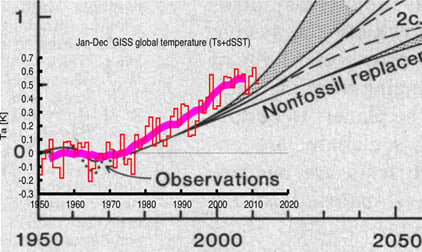Geert Jan van Oldenborgh and Rein Haarsma "stumbled across" – their words – a paper in the August 28, 1981 issue of Science,
written by a septet of climate modelers, which modeled a number of
scenarios that projected global mean temperatures up to the year 2100.
The lead author of that paper, "Climate Impact of Increasing Atmospheric Carbon Dioxide", was the now-famed and/or now-reviled James Hansen, currently working at NASA's Goddard Institute for Space Studies (GISS).
"It turns out to be a very interesting read," Oldenborgh and Haarsma say of the paper in their blog post on RealClimate.
Oldenborgh and Haarsma remind their readers that when the 1981 paper
was written, temperatures in the northern hemispheres were declining,
and global mean temperatures were below their 1940 levels. Despite those
facts, the KNMI researchers say, the paper's authors "confidently
predicted a rise in temperature due to increasing CO2 emissions."

The 1981 paper forecast a broad range of outcomes, but neglected uncertainty ranges
The paper's authors assumed that no action would be taken to rein in CO2
emissions until at least 1990, and so their projections don't begin to
deviate until that date. After 1990, they applied different sets of
variables to their models, ranging from a worst case in which
coal-derived synthetic fuels replace oil and gas and there is a large
increase in fuel usage, and a best case in which non-fossil fuels are
the replacement and there is no growth in their usage.
Oldenborgh and Haarsma took the 1981 paper's projections, and
overlayed upon them known temperature increases since 1981 as determined
by the GISS Land-Ocean Temperature Index, and using the KNMI Climate Explorer research tool.
"Given the many uncertainties at the time, notably the role of
aerosols, the agreement is very good indeed," write Oldenborgh and
Haarsma, comparing the results favorably with the far more sophisticated
coupled-model CMIP5 simulations.
The 1981 paper, the KNMI researchers conclude, is "a nice example of a
statement based on theory that could be falsified and up to now has
withstood the test. The 'global warming hypothesis' has been developed
according to the principles of sound science." 
No comments:
Post a Comment